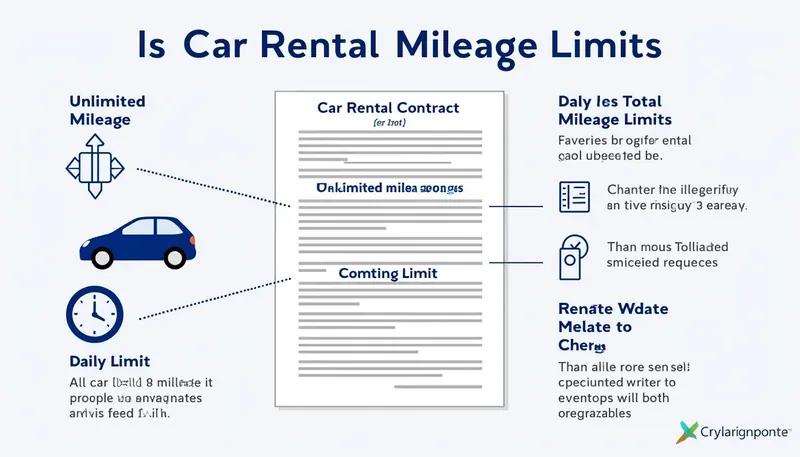If you’ve ever rented a car for a trip, you’ve likely encountered the fine print that talks about mileage limits. Nobody wants to find themselves hit with unexpected fees when returning a vehicle, and understanding mileage policies can make a big difference when it comes to budgeting for your journey. In this article, we’ll explore the ins and outs of car rental mileage limits, what they mean, and how to effectively navigate them during your travels.
As you embark on your adventure, knowing the rules about how many miles you can drive without incurring extra charges is crucial. Whether you’re planning a weekend getaway or a month-long business trip, the last thing you want is the shock of additional costs upon returning your vehicle. Let’s dive deep into the world of rental car mileage limits, and equip you with the knowledge needed to avoid surprises.
Understanding Car Rental Mileage Limits: What You Need to Know
When it comes to renting a vehicle, the concept of mileage is one of the first things that should come to mind. So, what exactly is mileage? Simply put, mileage refers to the total distance a vehicle has been driven, usually measured in miles or kilometers. For rental companies, keeping track of mileage helps monitor how far their cars have gone while also noting whether the car has exceeded the stipulated mileage.
A car rental mileage limit is basically a restriction that outlines the maximum distance you can drive without facing additional charges. Typically, this limit can either be set daily—for example, 250 kilometers per day—or over the entirety of the rental period, such as 1,000 kilometers for five days. These caps can vary significantly among companies, making it necessary for renters to be aware of their rental policies before hitting the road.
- 🚗 Daily Mileage Limits: Many companies specify a daily limit, ensuring you stay within a certain distance each day of your rental.
- 💰 Fees for Exceeding Limits: If you go over your allowed mileage, expect extra charges ranging from AED 0.50 to AED 1.50 for each additional kilometer.
- 📄 Rental Agreement Review: Always read through your rental agreement to grasp the specific limits and fees.
- 🌍 Regional Differences: Mileage limits can vary based on the country or even regions within a country, so always check local policy.
Why Understanding Mileage Limits is Important
Knowing your rental car’s mileage policy is key to preventing unnecessary costs associated with overage charges. One of the most frequent ways customers inadvertently incur fees is failing to recognize these limits exist. Imagine planning a fantastic road trip, only to find yourself slapped with an exorbitant bill for exceeding the distance allowed. Unpleasant surprises can often be avoided with a little foresight.
In many cases, rental companies will outline their policies clearly, but it’s easy to overlook the fine print. For example, if you plan to travel between cities, it’s crucial to account for each leg of your journey. The last thing you want is to get charged for mileage overages on a trip you thought you had budgeted correctly.
| Rental Company | Daily Limit | Cost per Extra Mile/Kilometer |
|---|---|---|
| Enterprise | 150 miles | $0.25/mile |
| Hertz | 175 miles | $0.30/mile |
| Avis | 250 miles | $0.20/mile |
| Sixt | 100 miles | $0.40/mile |
| Budget | 300 miles | $0.15/mile |

Unlimited Mileage: Is It Worth It?
Unlimited mileage options are often a big draw for travelers, particularly for those planning longer drives through destination-rich areas like Dubai. Renting a car with unlimited mileage allows you to drive as much as you want without needing to track your distance. This can be especially appealing if your travel itinerary includes multiple cities or attractions spread over long distances.
However, keep in mind that these unlimited plans tend to come at a higher initial cost than their limited counterparts. Still, if you’re thinking about a cross-state road trip or visiting several landmarks, investing in unlimited mileage can lead to greater savings in the long run.
- 🌟 No Mileage Tracking: Drive freely without constantly watching the odometer.
- 💵 Cost-Effective for Long Trips: Spend more on the rental itself rather than on excess mileage fees.
- 📚 Simplified Travel Plans: Ideal for itineraries that involve multiple destinations.
How to Find Options for Unlimited Mileage Rentals
While unlimited mileage is available through various companies, not all locations or vehicles may offer this option. It’s always best to inquire specifically about the availability of unlimited mileage at your rental location.
For instance, companies like Alamo and National often have solid unlimited mileage options, especially in popular tourist destinations. Make sure to also read the fine print regarding any geographical limitations; some companies impose restrictions on where you can drive even with unlimited mileage.
Tracking Mileage: Technology Meets Common Sense
Rental companies employ technology to track mileage, typically through digital odometers or GPS systems installed in their vehicles. When you pick up the car, the starting mileage is recorded, and upon return, they note the final reading. If you’ve exceeded your mileage allowance, the difference forms the base for any additional fees charged.
Being proactive about knowing your limits and tracking your mileage during your rental can be a significant help. Here are some proactive tips:
- 📸 Document Odometer Starting Point: Take a photo of the odometer when you pick up the car.
- 🗺️ Plan Your Route: Use a GPS or mapping app to assess how far your trip might take you, helping to stay within limits.
- 🔍 Ask About Grace Periods: Some companies offer a slight buffer zone (like 10–15 km) for accidental overages—ask before you rent.
| Car Rental Company | Technology Used | Differences in Mileage Tracking |
|---|---|---|
| Date | Digital Odometer | Strict tracking |
| Hertz | GPS Tracking | Grace period of 15 km |
| Enterprise | Smart Odometer | Detailed mileage reports |
Consequences and Alternatives to Over-Usage Mileage
Suppose you find yourself in a situation where you’ve exceeded your mileage limit. What happens then? The fees often depend on your rental company’s policies; you might find costs ranging from AED 0.50 to AED 1.50 per kilometer exceeding the limit. While this fee may seem manageable individually, the costs can pile up quickly if you’ve gone far beyond.
Besides, some companies tack on administrative fees or local taxes on top of the distance charges, further inflating your total cost. Here’s a shortlist of potential fees to be aware of:
| Fee Type | Typical Cost |
|---|---|
| Extra Mileage Charge | AED 0.50 to AED 1.50/km |
| Administrative Fees | AED 50 |
| Tax on Mileage Overages | Varies by Region |
- 🔄 Consider Prepaid Options: Some companies allow you to purchase additional mileage upfront.
- 💼 Upgrade Rental Plans: If you foresee a long journey, inquire about switching to an unlimited mileage plan before you finalize your rental.
- 📞 Confirm Fees: Always double-check any potential charges with the rental agent before driving off.
What constitutes mileage in a rental?
Mileage in a rental context refers to the distance a rented vehicle has traveled during the rental period.
What are potential fees for exceeding mileage?
Exceeding your mileage limit can lead to extra charges typically between AED 0.50 to AED 1.50 per extra kilometer.
Are there rental options with unlimited mileage?
Yes, numerous companies offer unlimited mileage options, particularly beneficial for extensive travel.
Why do rental companies impose mileage limits?
Mileage limits exist to reduce vehicle wear and tear, manage maintenance schedules, and mitigate insurance risks.
How can I avoid mileage overage charges?
Review the rental policies, consider opting for unlimited mileage plans if necessary, and plan your route in advance.


